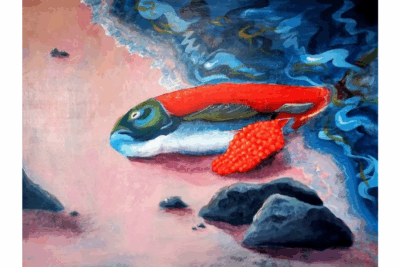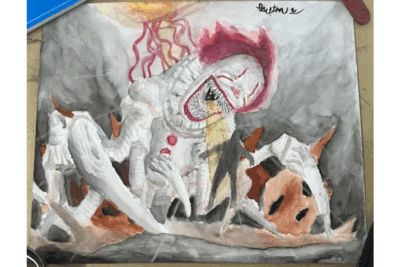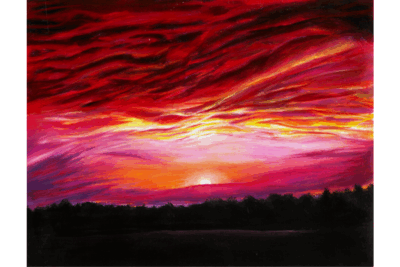Walk down to the basement of the Good Library and you’ll find a wide variety of art on display. The pieces, which range from pottery to collages to paintings to photography, are united by a common theme which doubles as the title of the exhibit: “Recycled.”
The theme was introduced at the beginning of the year and students across the visual art department began work last semester, according to Randy Horst, Goshen College art professor. Horst helped to coordinate the exhibit.“It’s another way of engaging ideas that are being brought up in a class context, in various convocations, and even in other art forms – like when issues are the subject matter of songs that are performed, or of plays,” said Horst. “This is an opportunity for visual arts students to be part of the same kind of broader campus dialogue.”
“There were a wide variety of visual approaches; that was something that we were pleased with, that we encouraged,” Horst said. “When you’re confronted with something you didn’t expect, it makes you contemplate the issue differently and make different connections.”
One featured piece is a ceramic bottle entitled “Regeneration,” created by Irina Gladun, a junior art and English student. The bottle appears to have several layers, which are peeling away from its sides almost like the petals of a rose.
“[The piece] was meant to emulate the shedding of skin and regeneration that some animals make use of to grow,” said Gladun. “My bottle sheds its skin several times to become new and to be used anew… My piece hopes that through recycling and regeneration we find ways to return to more permanent, biodegradable, environmentally friendly vessels.”
Nasim Rasoulipour, a sophomore interdisciplinary major, went a different direction. She worked from the perception of recycling as a kind of recovery in her piece “Healing Window.”
“The first thing that came to my mind was the Red Cross, which is portrayed in the main part of my piece,” she said. “It’s presented as a window, a worldview.”
Rasoulipour went on to say she wanted to show the ugliness, the dirtiness of how we’re ruining the world with technology, lack of caring and ignorance.
“We should see the world through this Red Cross but view it as a symbol of healing,” she said. “We should be working to help recover it.”
Dillon Hershey, a sophomore graphic design major, created a collage entitled “Generational” as a testament to objects and ideals that have been recycled by being passed down to her from her grandparents.
The exhibit is co-sponsored by the art department and the art club, who selected the theme cooperatively several years ago, according to Horst. He added that themes are chosen to tap into a number of aspects of different campus values.
Horst noted that the idea to have an exhibit with this particular theme started several years back, when a faculty member did a recycling project in an art class. “[The other art department faculty] all thought it was a great idea and saw that it could have a much larger application.”
He explained that a themed exhibit can be helpful as it allows the pieces to engage in a kind of “dialogue with each other.”
“That kind of contextualising allows other students and the rest of the campus community to engage,” he said. “Go down, spend a little time with these pieces, see what the visual experience is like. You can like a piece or not like a piece, but you can also be thinking – what is this saying about ideas of recycling, or reforming, or any of the other things that ‘Recycled’ implies?”
“I think it’s important for people to go in with an open mind, because the students themselves were working with an open mind,” Horst added. “That sense of being surprised, sometimes delighted, sometimes confused, that’s all part of the process and that’s part of a successful exhibit.”
The “Recycled” exhibit runs through February 19.


